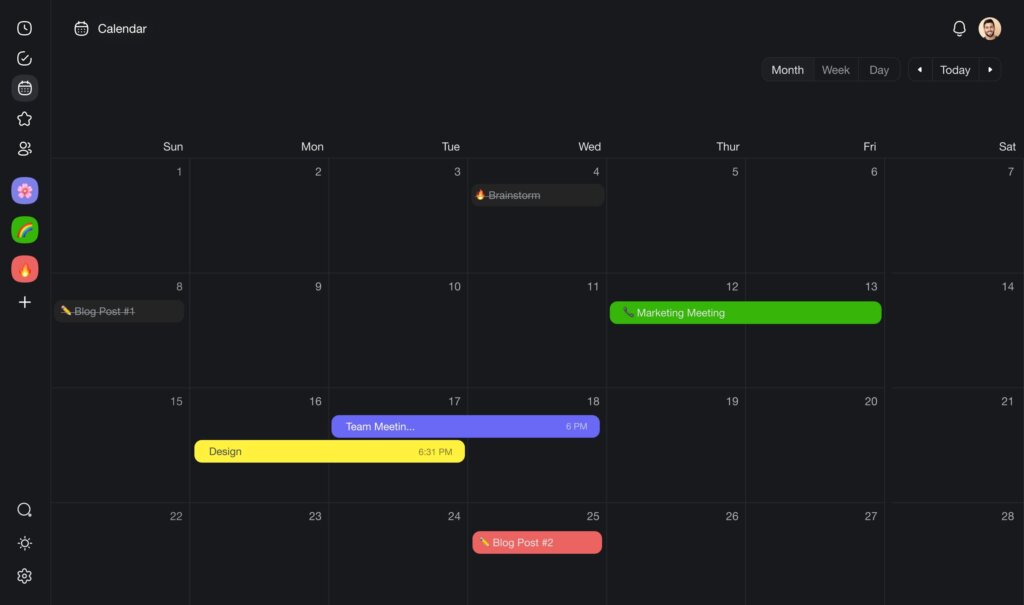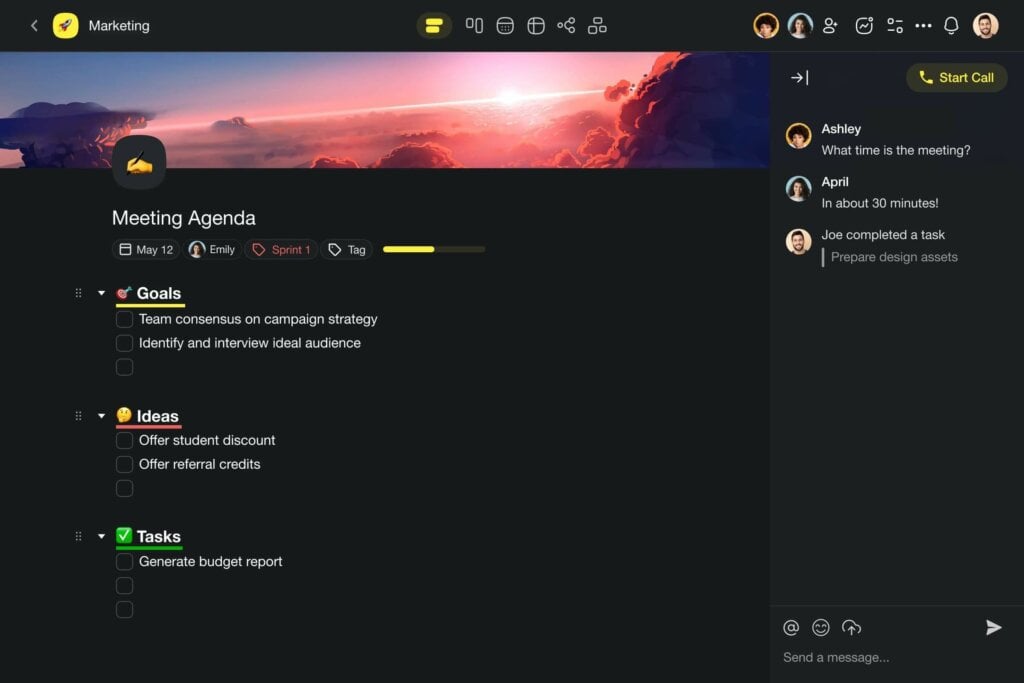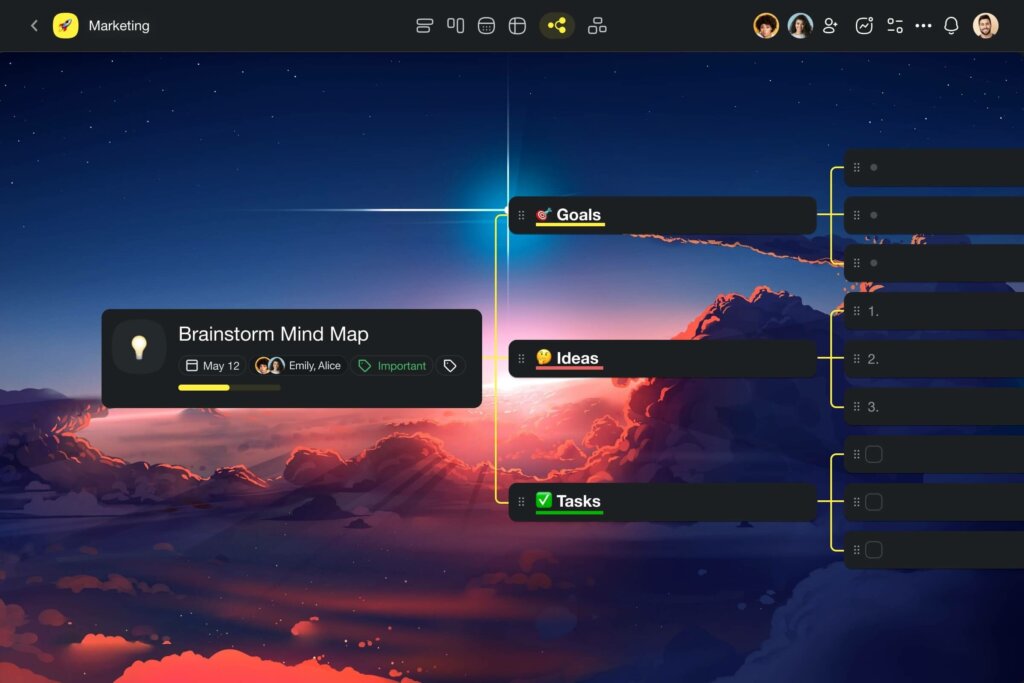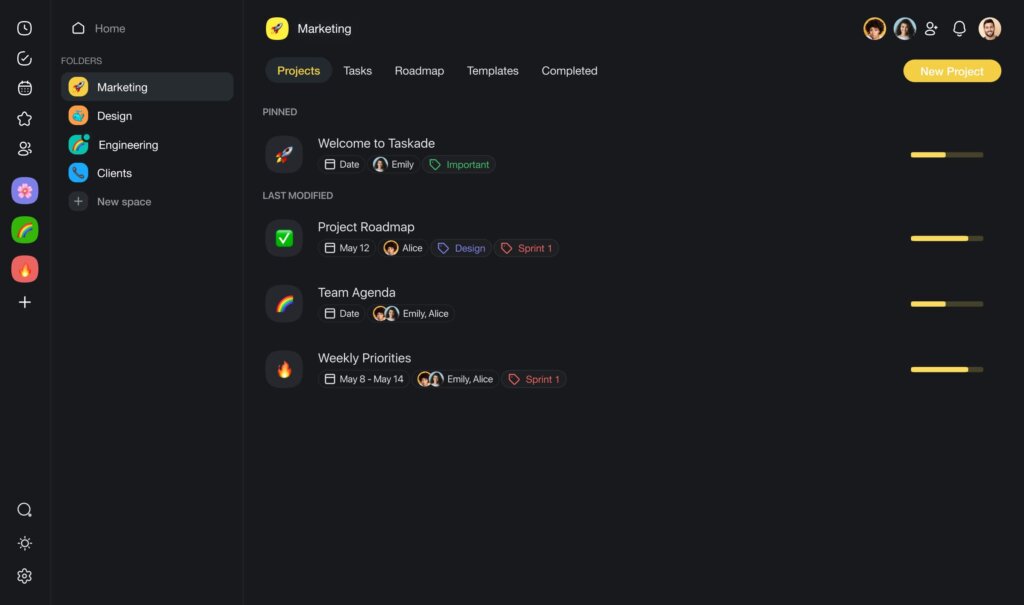Nailing remote work culture is tricky. While every distributed team (including yours!) needs one, you can’t exactly tame it overnight. It takes time, good leadership, the right kind of people…
What do you say we start from the beginning?
Sourcing global talent is a walk in the park. With remote work finally in the mainstream, you can put together a fully distributed organization in a jiffy. But your managerial goals don’t end there, do they?
In today’s article, we’ll show you how to leverage remote work culture to build a happy, well-aligned, and productive distributed organization.
💡 Before you start… At Taskade, we’re on a mission to help distributed teams thrive. Here are a few similar articles you should check out when done reading.
- 🌟 A Holistic Approach to Remote Leadership
- 🤔 Remote-Friendly vs. Remote-First Culture
- 🔥 Diffusing Conflict in Distributed Teams
- 👂 How to Overcome Poor Remote Communication
🌎 What Is Remote Work Culture?
As a concept, remote work culture or “team culture” is elusive at best. You can’t force, buy, or evaluate it with KPIs. No, you can’t prod it with a stick either.

So, what is it exactly?
Let’s start with APA’s “safe” definition of organizational culture:
“A distinctive pattern of thought and behavior shared by members of the same organization and reflected in their language, values, attitudes, beliefs, and customs. The culture of an organization is in many ways analogous to the personality of an individual.”(1)
Using that as a reference, we can say that organizational culture is a professional and personal narrative told by your team’s words and actions.
In a remote setting, constructing such a narrative requires a handful of additional ingredients you need to put some extra attention to. These include:
- 👩💻 Individual predispositions to remote work
- ⏰ Remote-specific soft skills like self-efficacy
- 💬 The ability to communicate effectively
Putting all that together, you can say remote work culture is your team’s unique story, complete with its own setting, vibrant characters, and plot twists. It defines where your team is coming from and where it is heading.

🤝 How Do You Create Remote Work Culture?
1. Crystallize a Vision of Your Dream Team
Do you want to attract new blood to your remote team? Good. You should start by asking yourself one simple question: “Is this the team I would kill to be a part of?”
If the answer is a reverberating “YES,” you should do just fine. But if you’re not truly passionate about what your organization stands for, you won’t find many followers.
According to researchers Rob Goffee and Gareth Jones, good company culture stems from authenticity on the management, employee, and organizational level.
“Simply put, people will not follow a leader they feel is inauthentic. But the executives we questioned made it clear that to be authentic, they needed to work for an authentic organization.”
Creating the Best Workplace on Earth via HBR(2)
So, what’s your dream workplace? What values does it prioritize? What kind of personal/professional dynamic would you expect as a potential hire?
Here are a few tips to get you started:
- 🌟 Define your dream remote workplace.
- 👂 Ask your team what kind of business they’d love to work for.
- 😎 Be authentic and create the team culture you believe in.
- 📣 Overcommunicate and listen to your team’s needs.
- ✏️ Create a gripping team narrative.
2. Build True Camaraderie
One of the benefits of a hands-on leadership style is the ability to get close to your team. A position of authority shouldn’t hamper a genuine human-human connection.
“[…] I think leadership has more to do with your ability to lead humans, which is different than manage humans. Lead humans is more like their well-being, your well-being, the organization’s well-being, the ability to make sure these individuals are highly motivated […]”
Hiten Shah via The Startup Chat(3)
Remote work culture needs team camaraderie that works both vertically and horizontally. You want to be as much a leader as an equal team member.
The thing is, many remote managers still find it difficult to solve the remote puzzle. According to the collaborative Remote Managers 2020 report:
- 👋 57% cite “lack of relationships among employees” as the key obstacle.
- 👂 47% believe remote communication is still far from perfect.
- ☝️ 45% say working remotely decreases employee visibility.(4)
The solution?
Create a deep bond with your team, simplify communication, increase transparency, and push the power dynamic toward shared leadership. Here’s how:
- 🤝 Be “team member” first and “manager” second.
- ⏰ Make time to talk to your team.
- 💡 Be transparent in decision-making.
- 🤝 Trust your team to do the right thing.
- 🌈 Avoid a one-size-fits-all approach.
- 🪓 Break down communication silos.

3. Preach (Few) Essential Values
Here’s the thing. You may boast about integrity and diversity in your values statement, but all those things are just empty words if they’re not backed by actions.
According to business management expert Patrick Lencioni, it’s much easier to preach organizational values in a marketing narrative than it is to actually practice them.
“Many companies view a values initiative in the same way they view a marketing launch: a onetime event measured by the initial attention it receives, not the authenticity of its contents.”
Make Your Values Mean Something by Patrick M. Lencioni(5)
Your team’s remote work culture has to be focused and built on essential core values. Those values should emanate both internally and externally, come hell or high water.
- 💬 Gather your team and brainstorm 2-3 core values.
- 📝 Weave those values into the team narrative.
- 🌟 Make core values part of regular team communication.
- 🤝 Align your hiring standards accordingly (see below).
- 🎉 Reward employees who live by those rules.
4. Start and End With the Right People
As a manager, your role is to make sure the team paddles in the same direction. But first, you need to assemble a strong crew that’ll go for the gold.
“So, how do I attract the best talent out there?”
Again, it all starts with your authenticity as the leader. People are more willing to follow you when you genuinely believe in your organization’s values and goals.
“You have to have a very compelling goal for the company. If you put yourself in the shoes of someone who’s talented at a world level, they have to believe that there’s potential for a great outcome and believe in the leader of the company, that you’re the right guy to work with […].”
Elon Musk(6)
Many distributed teams lack the “tactility” of co-located organizations. There’s not enough human-human connection to kindle the spirit of kinship and camaraderie.
Here’s what you can do to fix that:
- 🤝 Hire for a cultural fit and soft skills.
- 📣 Look for strong communication skills.
- 🐌 Don’t overprovision and grow slowly.
- 🏆 Reward team members with strong alignment.
- 🙋♂️ Become an authentic and approachable leader.

5. Become a Servant Leader
According to the concept of servant leadership, leaders should serve members of their organization to support its growth. Think of it as organizational structure upside down.
Robert K. Greenleaf, the founder of the Servant Leadership movement argued that:
“A servant-leader is a person who begins with the natural feeling of wanting to serve first –to help, support, encourage, and lift up others. And because of their noble role model, others begin to lead by serving.”(7)
To build the right kind of remote work culture, you should become a servant leader. But first, you need to identify the needs of your team and organization.
Start with these questions:
- 👉 How do you support your team’s growth?
- 👉 What other steps can you take to help them?
- 👉 Do you really know what kind of help they expect?
- 👉 How do you reward your team’s performance?
- 👉 Is your team’s organizational structure flat enough?
- 👉 Does it support or hamper communication?
- 👉 How transparent is the decision-making process?
Don’t expect your team to blindly accept the values you impose. Instead, lead by example and support them every step of the way. Become a servant leader.
6. Keep Tabs on Wellbeing
Remote work culture is like a badge of honor. It shows clients, stakeholders, suppliers, and potential hires that your team/organization is built on the right values.
But before you get the bragging rights, there’s one more thing we need to discuss.
While many workers welcomed the 180 to remote work, some are still struggling to settle in the new reality. Distractions at home, suboptimal working conditions, and prolonged isolation are all taking a toll on our mental health.
The result?
- 32% of remote workers experience stress at home.(8)
- 74% of employees say their mental health negatively affects productivity.(8)
- 75% of employees experienced burnout in 2020.(9)
- 24% of remote workers struggle to unplug after work.(10)
- 27% of remote workers can’t focus and find motivation at home.(10)
Mental health and wellbeing are essential ingredients of remote work culture. You need to stay vigilant about both if you want to build a healthy distributed team.
Here are a handful of tips to get you started:
- 🚨 Look for remote work burnout red flags.
- 👥 Offer 1-on-1 mentoring and guidance.
- 👋 Check in with the team as often as possible.
- 🔕 Practice daily communication blackouts.
- 🔌 Make “unplugging” part of the team culture.
- ❤️ Join the “Unsick Day” initiative (click).
And that’s it!

🐑 Conclusion
Many companies try to jump on the “cool” bandwagon by stuffing their PR materials with lofty slogans, splurging on benefits, and stealing mission statements from others.
But we already know that doesn’t work, right? If anything, those things stack up to a fake organizational culture that’ll come crashing down at the slightest hint of adversity.
To build strong remote work culture, you need to start with authenticity, transparency, and trust. Once you’ve nailed that, it’ll be all downhill from there.
Let’s recap what we learned today. 👇
- 🌟 Crystallize a vision of your dream team.
- 🤝 Build true team camaraderie.
- 🎯 Preach (few) essential values.
- 👥 Start and end with the right people.
- 🤲 Become a servant leader.
- ☝️ Keep tabs on mental health and wellbeing.
Alright, let’s shift gears and dive into something cool.
Workplace culture is a key driver of collaboration in remote teams. But if you’re struggling to build on for your team, Taskade AI is here to help.
- 🌐 AI Workflow Generator: Imagine a tool that whips up workflows as if by magic. Taskade AI does just that. It analyzes your team’s needs and crafts custom workflows, making sure everything’s organized and running smoothly. No more chaos, just clear, streamlined tasks.
- 🧠 AI-Powered Task Management: Task management can be a headache, right? Not anymore. With Taskade AI, your tasks are sorted, prioritized, and managed, just like that. It’s like having a personal assistant who knows exactly what needs to be done and when.




- 💬 Taskade AI Chat: Ever wished for a team advisor available 24/7? Meet Taskade AI’s interactive chat. It’s not your average chatbot; it will help you uncover valuable insights, answer questions, solve complex problems, and suggests ideas to boost productivity.
- 🤖 Custom AI Agents: This is where AI goes full sci-fi. Taskade AI lets you create custom AI agents tailored to your team’s workflow. Automate routine tasks, eliminate the mundane, and free up your time for the big-picture stuff.

🔗 Resources
- https://dictionary.apa.org/organizational-culture
- https://hbr.org/2013/05/creating-the-best-workplace-on-earth
- https://thestartupchat.com/ep091/
- https://remote-how.com/receive/request-form-1?ref=RM-Report
- https://hbr.org/2002/07/make-your-values-mean-something
- https://www.businessinsider.com/brilliant-elon-musk-quotes-2015-9?IR=T
- https://www.greenleaf.org/what-is-servant-leadership/
- https://www.aetnainternational.com/en/about-us/explore/future-health/polarised-perceptions.html
- https://www.flexjobs.com/blog/post/flexjobs-mha-mental-health-workplace-pandemic/
- https://buffer.com/2021-state-of-remote-work


 How to Plan Effective Project Team Meetings: Strategies for Success
How to Plan Effective Project Team Meetings: Strategies for Success  14 Best AI Tools for Planning and Running Meetings
14 Best AI Tools for Planning and Running Meetings  Creating Customer Service SOPs: A Guide for Streamlining Your Support
Creating Customer Service SOPs: A Guide for Streamlining Your Support  15 Top AI Content Marketing Tools for Remote Teams
15 Top AI Content Marketing Tools for Remote Teams  9 Top AI Brainstorming Tools for Virtual Teams in 2025
9 Top AI Brainstorming Tools for Virtual Teams in 2025  14 Best AI Collaboration Tools for Remote Teams (Updated 2025)
14 Best AI Collaboration Tools for Remote Teams (Updated 2025)